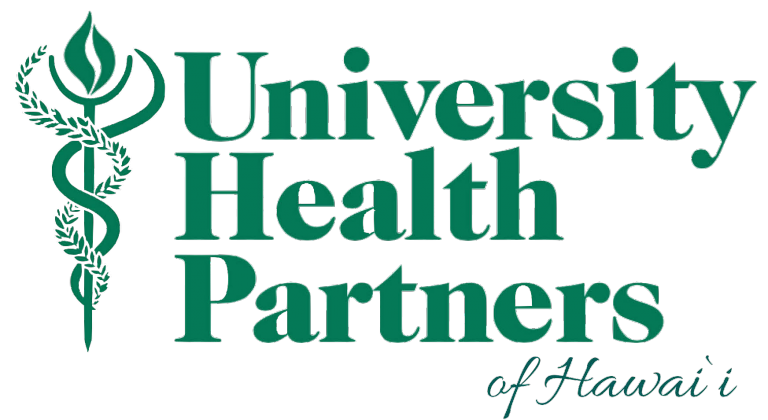Featured photo: The Otoacoustic Emissions Device, as demonstrated by Dr. Lisa Taniguchi’s daughter.
Written by Marybeth Kotrodimos, University Health Partners of Hawaii
Photo submitted by Dr. Lisa Taniguchi
The clinicians at University Health Partners’ Speech and Hearing Clinic (UHPSHC) are very dedicated and very good at what they do. Their work has benefited not just our Island communities, but also communities across the globe. And now, they have become even more efficient at testing your hearing, thanks to a small device that records the sounds reflected by the hair cells in your inner ear, known as Otoacoustic Emissions (OAE).
Since she began working for UHPSHC as an audiologist about three years ago, Dr. Lisa Taniguchi has been wanting an OAE device for the clinic. She knew that this little machine would not only enable the clinic to expand their testing population, but would also help them to provide a stronger diagnosis for any patient with auditory or hearing related problems, and it would do so in far less time and fewer office visits.
The traditional method of testing a patient’s hearing familiar to most of us is one in which the patient puts on headphones and raises a hand or responds behaviorally when they hear a tone. But how does this work for very young children or for people who cannot respond accurately due to disability or injury? The answer is that, for these populations, it doesn’t work very well – or very efficiently.
Dr. Taniguchi notes that getting young children to respond reliably in these tests is truly a challenge. “I would interview the patient’s parents and see how we could get them to respond behaviorally. Also, I would inquire if they could follow two- or three-step instructions,” she tells us. “Young children might not follow these instructions properly, so we typically get them to respond using play techniques. We say, ‘Whenever you hear the little birdy, throw the ball in the bucket’ or something to that nature. But we can’t always trust their reliability. They may be resistant or they might just want to continue to play instead of completing the task at hand.”
Previously, for children who were too young to have acquired language skills, as well as those children who could not reliably respond after multiple attempts, “We referred them to Kapiolani Medical Center where they could obtain objective results,” Dr. Taniguchi says..
“Our previous testing population was for patients five years and older,” she adds, “but with the OAE device, I feel comfortable testing children as young as one or two years of age, since the patient is not required to respond at all.”
Among those adult patients who cannot respond, those with autism or aphasia resulting from a stroke, traditional hearing tests can also be challenging. “I’m excited that we can assess these populations more efficiently,” Dr. Taniguchi says.
Before they acquired the OAE device, “we would still test them within our capacity,” she explains, “but I’d have to break up their visits into different appointments, document that their reliability was poor, and re-evaluate them at a later date or refer them to other clinics that have objective testing equipment.”
With the OAE device, “I get what I need very quickly and it will help supplement the information that I subjectively obtain. It minimizes the back and forth and the steps in-between.”
The OAE device can also help test those who don’t normally suffer from a hearing loss but have other auditory health issues. “We can work with tinnitus patients, and early detect patients who are at risk for hearing loss due to noise exposure or ototoxicity,” she said. “I can provide patients with a more comprehensive diagnosis.”
So what does an OAE do that has revolutionized the way hearing is tested?
“I explain to patients that the equipment is an echo device,” Dr. Taniguchi says. “Essentially, we’re introducing tones to the ear and the device records echo responses to those presented tones. If the hair cells in the inner ear are healthy, we would obtain robust echoes. If they are damaged due to noise, aging, family genetics, medication or other factors, the echo would be reduced or absent.”
The OAE technology is not new, but due to funding concerns, UHPSHC was not able to acquire it until they became the recipients of the Oscar and Rosetta Fish Fund Grant. This grant provided funds to test and treat children ages three through five with speech, language and/or hearing issues.
But it’s not just these young patients or patients with hearing concerns who will benefit. UHPSHC will use the OAE device to screen all patients and identify if they are at risk for hearing loss. This OAE equipment, Dr. Taniguchi says, renders “a nice objective assessment of how an individual’s hearing system really works.”
And because the machine is “portable,” she adds, “it can benefit a lot of people in the community.” Known for keeping a busy schedule of community outreach work, Dr. Taniguchi will bring the device with her to community screenings, “It is going to allow us to reach out to more people that need help,” she says.
With her characteristic humility, Dr. Taniguchi credited her colleagues for the work they did to bring the OAE to UHPSHC. “All thanks go to the team,” she said, “to Dr. Pauline Mashima (Program Director) and Mr. Keith Yamase (Fiscal and Administrative Specialist) and everyone who was a part of obtaining the Fish Fund Grant.” Because of them and this portable device, “we can strengthen what were already providing.” And considering all that this clinic provides, that says a lot.

